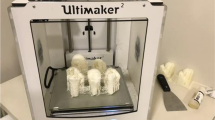Abstract
Purpose
Osteosynthesis of proximal humeral fractures remains challenging with high reported failure rates. Understanding the fracture type is mandatory in surgical treatment to achieve an optimal anatomical reduction. Therefore, a better classification ability resulting in improved understanding of the fracture pattern is important for preoperative planning. The purpose was to investigate the feasibility and added value of advanced visualization of segmented 3D computed tomography (CT) images in fracture classification.
Methods
Seventeen patients treated with either plate-screw-osteosynthesis or shoulder hemi-prosthesis between 2015 and 2019 were included. All preoperative CT scans were segmented to indicate every fracture fragment in a different color. Classification ability was tested in 21 orthopaedic residents and 12 shoulder surgeons. Both groups were asked to classify fractures using three different modalities (standard CT scan, 3D reconstruction model, and 3D segmented model) into three different classification systems (Neer, AO/OTA and LEGO).
Results
All participants were able to classify the fractures more accurately into all three classification systems after evaluating the segmented three-dimensional (3D) models compared to both 2D slice-wise evaluation and 3D reconstruction model. This finding was significant (p < 0.005) with an average success rate of 94%. The participants experienced significantly more difficulties classifying fractures according to the LEGO system than the other two classifications.
Conclusion
Segmentation of CT scans added value to the proximal humeral fracture classification, since orthopaedic surgeons were able to classify fractures significantly better into the AO/OTA, Neer, and LEGO classification systems compared to both standard 2D slice-wise evaluation and 3D reconstruction model.


Similar content being viewed by others
References
Court-Brown CM, Garg A, McQueen MM. The epidemiology of proximal humeral fractures. Acta Orthop. 2001;72:365–71.
Burkhart KJ, Dietz SO, Bastian L, Thelen U, Hoffmann R, Müller LP. Behandlung der proximalen Humerusfraktur des Erwachsenen. Dtsch Arztebl Int. 2013;110:591–7.
Hardeman F, Bollars P, Donnelly M, Bellemans J, Nijs S. Predictive factors for functional outcome and failure in angular stable osteosynthesis of the proximal humerus. Injury. 2012;43:153–8.
Krappinger D, Bizzotto N, Riedmann S, Kammerlander C, Hengg C, Kralinger FS. Predicting failure after surgical fixation of proximal humerus fractures. Injury. 2011;42:1283–8. https://doi.org/10.1016/j.injury.2011.01.017(Elsevier Ltd).
Meier RA, Messmer P, Regazzoni P, Rothfischer W, Gross T. Unexpected high complication rate following internal fixation of unstable proximal humerus fractures with an angled blade plate. J Orthop Trauma. 2006;20:253–60.
Agudelo J, Schurmann M, Stahel P, Helwig P, Morgan SJ, Zechel W, et al. Analysis of efficacy and failure in proximal humerus fractures treated with locking plates. J Orthop Trauma. 2007;21:676–81.
Kralinger F, Blauth M, Goldhahn J, Käch K, Voigt C, Platz A, et al. The influence of local bone density on the outcome of one hundred and fifty proximal humeral fractures treated with a locking plate. J Bone Joint Surg Am. 2014;96:1026–32.
Neer CS. 2nd. Displaced proximal humeral fractures: part I. Classification and evaluation. 1970. Clin Orthop Relat Res. 2006;442:77–82.
Meinberg E, Agel J, Roberts C. Fracture and dislocation classification compendium—2018. J Orthop Trauma. 2018;32:s1–s10.
Hertel R, Hempfing A, Stiehler M, Leunig M. Predictors of humeral head ischemia after intracapsular fracture of the proximal humerus. J shoulder Elb Surg. 2004;13:427–33.
Codman E. Fractures in relation to the subacromial bursa. The shoulder. Boston: Thomas Todd; 1934.
Neer CS. 2nd. Displaced proximal humeral fractures. Part I. Classification and evaluation By Charles S. Neer, I 1970. Clin Orthop Relat Res. 1987;223:3–10.
Papakonstantinou MK, Hart MJ, Farrugia R, Gabbe BJ, Kamali Moaveni A, van Bavel D, et al. Interobserver agreement of Neer and AO classifications for proximal humeral fractures. ANZ J Surg. 2016;86:280–4. https://doi.org/10.1111/ans.13451.
Burstein AH. Fracture classification systems: do they work and are they useful? J Bone Joint Surg Am. 1993;75:1743–4.
Fürnstahl P, Székely G, Gerber C, Hodler J, Snedeker JG, Harders M. Computer assisted reconstruction of complex proximal humerus fractures for preoperative planning. Med Image Anal. 2012;16:704–20.
Khanna K, Brabston EW, Qayyum U, Gardner TR, Levine WN, Jobin CM, et al. Proximal Humerus Fracture 3-D Modeling. Am J Orthop (Belle Mead NJ). 2018;47:4.
Xia S, Zhang Y, Wang X, Wang Z, Wang W, Ma X, et al. Computerized virtual surgery planning for ORIF of proximal humeral fractures. Orthopedics. 2015;38:e428–e433433.
Chen Y, Zhang K, Qiang M, Li H, Dai H. Computer-assisted preoperative planning for proximal humeral fractures by minimally invasive plate osteosynthesis. Chin Med J (Engl). 2014;127:3278–85.
You W, Liu LJ, Chen HX, Xiong JY, Wang DM, Huang JH, et al. Application of 3D printing technology on the treatment of complex proximal humeral fractures (Neer3-part and 4-part) in old people. Orthop Traumatol Surg Res. 2016;102:897–903.
Wang D, Zhang K, Qiang M, Jia X, Chen Y. Computer-assisted preoperative planning improves the learning curve of PFNA-II in the treatment of intertrochanteric femoral fractures. BMC Musculoskelet Disord. 2020;21:34. https://doi.org/10.1186/s12891-020-3048-4.
Acknowledgements
The authors are not compensated, and there are no other institutional subsidies, corporate affiliations, or funding sources supporting this work unless clearly documented and disclosed. This investigation was performed with the assistance of the AO Foundation. The authors would like to thank Carolin Danker for her contributions to writing of the semi-automatic segmentation program.
Funding
None.
Author information
Authors and Affiliations
Corresponding author
Ethics declarations
Conflict of interest
Stefaan Nijs reports grants from DePuy Synthes, as well as personal fees from DePuy Synthes, Zimmer Biomet, and Mathys Medical that are outside the submitted work. The other authors declare that they have no conflicts of interest to disclose.
Ethical approval
This retrospective study was approved by the ethical committee of the hospital AZ Groeninge, Kortrijk. Study number AZGS2019072.
Rights and permissions
About this article
Cite this article
Dauwe, J., Mys, K., Putzeys, G. et al. Advanced CT visualization improves the accuracy of orthopaedic trauma surgeons and residents in classifying proximal humeral fractures: a feasibility study. Eur J Trauma Emerg Surg 48, 4523–4529 (2022). https://doi.org/10.1007/s00068-020-01457-3
Received:
Accepted:
Published:
Issue Date:
DOI: https://doi.org/10.1007/s00068-020-01457-3




